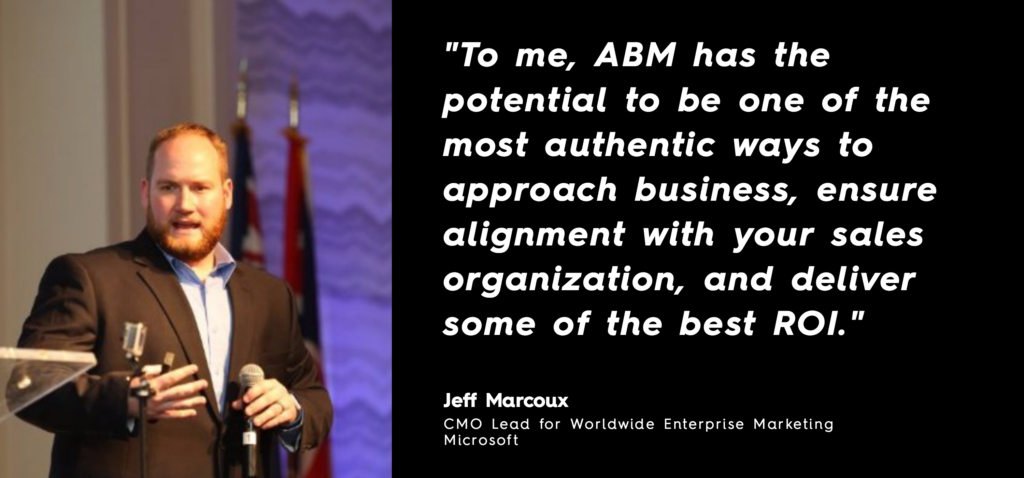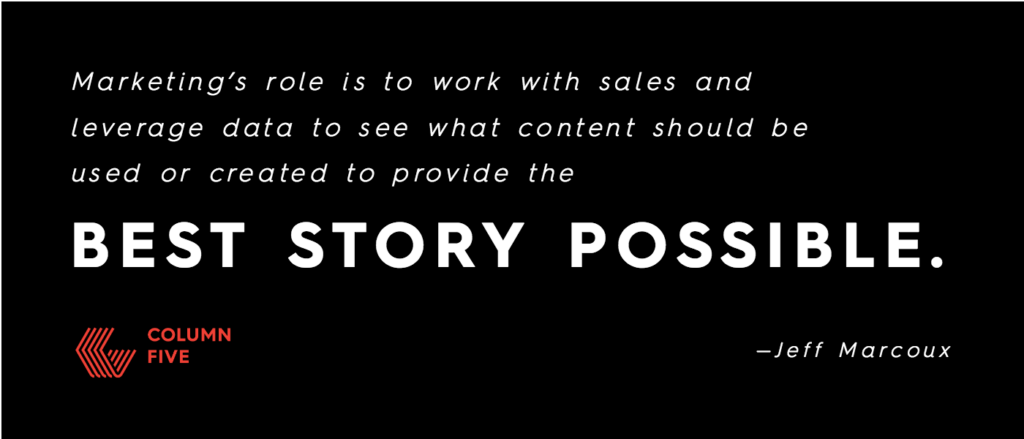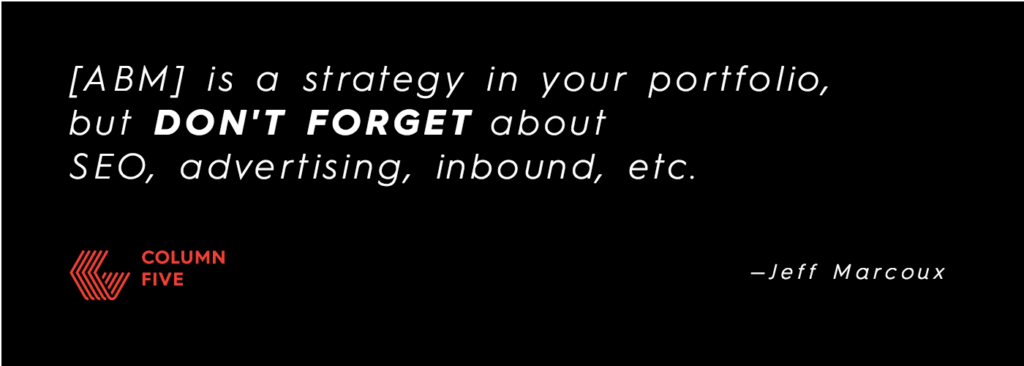Jeff Marcoux knows a thing or two about creating an effective buyer’s journey, especially when it comes to Account-Based Marketing (ABM). He’s the CMO Lead for Worldwide Enterprise Marketing at Microsoft, a professor of marketing at UC Irvine, and an Internet Marketing Association board member. In short: He lives and breathes marketing, and he has become a huge proponent of ABM.
If you’re looking to deliver value to your customers, it’s a marketing strategy you might want to embrace. Now.
Jeff was kind enough to chat with us about all things Account-Based Marketing, from why it works to how to get started. Read on for his great insights.

C5: Can you give us an overview of your role at Microsoft? Or, in layperson terms, “What would you say you do around here?”
JM: I get to wear two distinct hats at Microsoft, and they are both a lot of fun.
One hat lets me be one of Microsoft’s primary evangelists to marketers and digital agencies. I get to look across the entire Microsoft technology portfolio, from Bing Ads to artificial intelligence and everything in between, as well as all of our partner technologies. Then I get to work with some of the biggest brands in the world to figure out how we can help them create better customer experiences and drive bottom-line growth through marketing. This role requires me to stay up-to-date on all the latest trends, buzzwords, and technologies across B2B and B2C.
The other hat I wear is focused on driving hyper growth for a new SaaS product called Mobile Center. Here I get to sit at the intersection between engineering and marketing and focus on product virility, net new user acquisition, and demand generation.
C5: When did you become more focused on Account-Based Marketing as a practice?
JM: In my evangelism role, I began to see this trend emerge before it was popular. I realized that a lot of it was an extension of account planning and what I called existing customer marketing.
However, the real opportunity was in the predictive lead generation strategies that were using data science combined with ABM. With a team, I had the opportunity to implement one of these predictive strategies with great success at Microsoft.
C5: What do you think is behind the recent surge in popularity of ABM?
JM: I think the surge in popularity is due to the fact that marketers are looking for “what is next” beyond marketing automation and content marketing, the next “silver bullet.”
Additionally, there are a lot of great people who were founders of MarTech who were also looking for the next thing to build. We have seen the rise in Account-Based Marketing software, data enrichment tied to that, and predictive lead generation and lead scoring technologies all bubbling up as new areas of either investment or standalone MarTech.
So I think it is a mix of the maturity in data science and data enrichment technology tied with the fact that brands are trying to find new ways to differentiate themselves and fill their pipeline.
C5: Why do you find ABM so interesting, or so effective?
JM: To me, Account-Based Marketing has the potential to be one of the most authentic ways to approach business, ensure alignment with your sales organization, and deliver some of the best ROI.
The authenticity comes in account planning with your sales team to truly examine what you can offer that your targeted accounts need most. It’s not just what you want to sell them but where you can deliver true value in context of their business and what they need today.
Additionally, with predictive lead generation, you are able to identify companies putting out signals that they are 1) in need of what your business has to offer and 2) looking for a solution like yours.
Lastly, the sales alignment is incredible because marketing and sales have to work together. You’re predominantly handing over leads that have used machine learning to indicate they are a good fit for your product and are ready to buy, or you’re helping them further expand inside of their current accounts, both of which sales loves. These also require the right content to tell the right story.
C5: What type of alignment do you need to have between your sales and marketing to implement ABM?
JM: It is absolutely critical to look at what the approach will be for each of your different scenarios:
- Planned ABM: Developing a target list of accounts that you would like to get inside of and building a targeted strategy across sales and marketing to achieve that.
- Existing Account Expansion: Working with your sales team to set goals for existing accounts, which marketing supports by identifying decision makers and providing content to support the sales cycle.
- Predictive Lead Gen: Using machine learning and data enrichment to create a lookalike model and monitor purchasing intent and signals to identify when a business is indicating they are in market for what you have to sell. When doing this strategy, sales has to understand what the value model you’re using provides and be willing to engage with those accounts instead of letting them sit in a marketing nurture stream, waiting for the traditional “lead score” threshold to be reached.
- Opportunistic: These are the accounts still hitting your website that you identify by reverse IP lookup or form conversion. If an account is deemed enough value, you can pull it from the traditional nurture stream and begin an ABM program directed at them at scale.
Thus, ensuring that sales is aware of what you’re doing and is onboard to accept the leads, information, and content you will be providing to them is absolutely critical. The strategy will fall apart if you are not working together and on the same page with the right processes in place.
C5: What types of stories do you recommend telling in this more intimate marketing environment?
JM: I think the key is to understand what the target account truly needs and what value your business can deliver to help fill those needs. This comes back to the authenticity piece of not pushing your agenda but truly using data to identify the next best product or service your client needs.
Additionally, you can fill out this picture with data enrichment and machine learning to know what purchasing intent signals they are putting out so that you can align your content and stories to those signals.

C5: Where/how does analytics play a role in ABM efforts?
JM: In my opinion, analytics is the most important part of ABM. You have to understand who you need to talk to in an account, for what product, as well as what motivates them, what content should be used in targeting, how to best equip your sales team for success, etc.
If you expand into predictive, analytics plays an even larger part in identifying lookalike accounts that aren’t even on your radar so you can build your strategy from there around targeting, content, etc.
One last area that I believe all companies should be using is intelligent lead scoring so that you can truly understand when a lead is ready to engage with sales vs. having an arbitrary score based on a few people in a room saying a click is worth X points and a web page visit is worth Y points.
C5: In a given campaign, how much time do you dedicate to compiling a campaign for each account?
JM: It depends, as there is no one size fits all answer here. It depends on the size of the account, how much new business we think we are likely to get, if we have an existing relationship or not, what the competitive situation looks like, etc.
Often if you have already created a library of content, imagery, and other assets by industry, role, or geo-location, you can significantly decrease the amount of prep time it takes to begin executing.
Two other factors that impact timeline are the tools at your team’s disposal and your advertising strategy.
C5: How do you prioritize/organize accounts at a gigantic company like Microsoft?
JM: This is done on multiple levels at Microsoft. We have our top strategic accounts, our enterprise accounts, managed accounts, and then work our way down below that. We also have a geographic approach, and often the subsidiary will have specific accounts they wish to target as well.
C5: What is a justified spend/cost per account, or how should you calculate?
JM: This is something that should vary for every company. There are key factors like lifetime value, customer acquisition cost, etc. to consider. Once you have an understanding of what different types of accounts mean in terms of value to your business, you are able to know how much you should spend to expand in an account or start a new ABM strategy.
C5: What impact are you seeing on the customer lifetime value from Account-Based Marketing?
JM: I have seen substantial CLV growth when ABM is done right and you keep your customer focus. If you are using predictive lead generation and have the ability to identify what a customer needs through data, this ensures you are coming in at the right time with the right message with the right product to fulfill that need. Thus, you will be successful.
I can’t share exact numbers, but we saw substantial increases in both closed-won rates and deal size when we implemented this strategy. Additionally, if you continue monitoring your existing customer base, you can detect whenever they have a need that they may not be surfacing to your sales team and/or be able to predict when they may be likely to churn. Both of these enable you to be proactive in maintaining the relationship.
However, even the best ABM strategy can be destroyed by bad customer experience and churn. So it is key to examine the entire customer journey and ensure that your ABM strategy is backed up by a focus on making your customers successful and happy.
C5: How do you test messaging? How critical is testing?
JM: Message testing can be done relatively quickly with a small amount of advertising spend. You can test many different messages to the exact same audience and observe which ones drive the most desired actions. I’m a fan of using PPC to do it quickly and at scale before deploying a very large campaign.
C5: What are some of the best ways to work efficiently without losing the personal focus of ABM (e.g., template system with a workflow for customizing and tailoring according to client needs)?
JM: One of the easiest things to do is to start with a content audit and look at where your content gaps are in the purchasing journey. Also decide how you want to segment your accounts (size, industry, other, etc.). This enables you to see what you have today, where you can start strong, and where you have gaps that need filling.
Another easy way to get efficiency is to start by partnering with your sales teams on their most strategic accounts and building out ABM plans around those.
It will take you a bit to get your predictive programs in place, so start making your list of target accounts, do your content audit, and work with your sales team to put a plan in place around your most strategic accounts.
C5: What are the most common mistakes you see people making with ABM?
JM: One of the biggest is to think that they need big expensive software to get going. Honestly, Excel works great and is good enough for most companies to get going, and a little research by your team can begin some of the enrichment.
Build a plan and start to execute, then gain more efficiency with software. Another major mistake marketing teams make is not aligning with sales before starting an Account-Based Marketing plan. That assumes that ABM is a silver bullet and the only marketing you need to be successful.

C5: Any final pieces of advice for people looking to pursue ABM?
JM: I think ABM has some incredible promise and can really help companies become much more focused on creating amazing customer experiences across the entire company.
However, it is not a silver bullet. It still requires you to have a holistic marketing strategy. Additionally, I think a common trap is over-investing in ABM technology when Excel may be good enough for your business to start.
The last and arguably most important thing to remember is that analytics is key. From data enrichment, research, next best product/service recommendations to predictive lead generation and predictive lead scoring, you absolutely must have a data strategy to identify what data you need and which holes to fill.
I am definitely bullish on ABM, but proceed with caution and planning.
Many thanks to Jeff Marcoux for sharing his thoughts with us. Catch up with him on Twitter @jeffmarcoux or LinkedIn. For more wisdom from game-changers in content marketing and content strategy, check out these Q&As:
- CoSchedule shares the content strategy that increased traffic six-fold.
- PopSugar’s snap queens share their expert tips on how to run the best brand Snapchat.
- Business Insider’s Mike Nudelman tells us what publishers want from your content.
- LinkedIn’s Alex Rynne explains how to use LinkedIn to build your personal and professional brand.
Of course, if you need any help with your own content strategy, we’d love to chat.




